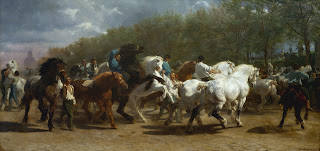In the Middle Ages, Europe was dominated by men and the church. Women played the role of wife and mother. Nothing else. Women were “the virtual prisoners of the men in their lives” (Guerrilla Girls 19). Women were not allowed to receive an education, unless their male figure gave them permission and their opinions were invalid. Before women were married, they were their father’s property. Women were married off at a young age to the highest bidder. Marriage was seen as transaction. Marrying a young woman was based off of what the male could provide for her and her family. Marriage was often arranged and was not based off of love. After the woman is married off she is the husband’s property and expected to have children and take care of the children. The women did not have a career of her own and was submissive to her husband and other male figures around
 |
1. Hildegard Von Bingen,1089-1179,
Abbess of Nunnery, Mystic, Writer,
Philosopher, Polymath.
|
If she opposed her husband or other male figures she was subject to be punished, nowadays known as domestic abuse. According to St. Paul, “a woman must be a leaner, listening quietly and with die submission. I do not permit a woman to be a teacher, nor must a woman domineer over a man; she should be quiet.” (Chadwick 45) A wife, a women in general, was meant to be seen, not heard. The church played a role in a woman's life by controlling how she should present herself in society. According to the church the women would be submissive to her husband and continuously procreate to keep the faith abundant of followers. An alternative to marriage was becoming a nun in the church. As stated in the Guerilla Girls, becoming a nun released women of their duties aligned with being a mother and wife. Although nuns were controlled by religion, “they operated businesses, farmed, made tapestries … and they educated one another.” (Guerrilla Girls 22) The image to the right is of Hildegard Von Bingen, a famous artist and abbess during these times.Women during the middle ages were fierce authors, warriors, nuns, and artist.
 |
| 2. Artemisia Gentileschi, Susana and the Elders, 1610 |
 |
| 3. Tintoretto, Susana and the Elders, 1555 |
Women artists also portrayed women in more powerful personas. Gentileschi’s Judith Slaying Holofernes, convey the idea that women are not fragile. The traditional role of women described as frail or feeble minded is not found in this work. Judith and her maidservant are able to complete the task at hand. The women are depicted as strong and being able to “face carnage and death.” (Guerilla Girls 37)
During the 19th century, women were still oppressed but not as much. The struggle for gender equality kicked off in the 19th century. Women had to fight to be taken seriously, but were heard nonetheless. Women were still taught to be submissive and hold traditional feminine roles, such as a wife and mother. Professional education was still not supported by society, but women had the chance to attend medical or law school. Successfully completing these schools as a women was hard due to the environment working against female students. New technologies were introduced, such as the camera, which threatened to make painting obsolete. This was great for women, because it was brand new and men could not exclude them, or set a different bar of professionalism. Men could not control photography and block women out of progressing with the camera. As a result, women aided in establishing the practice.
 |
| 4. Rosa Bonheur, The Horse Fair, 1887 |
Artist during the 19th century such as Rosa Bonheur pushed limits and never settled for anything less than what she wanted. Bonheur came from a family that believed in equality and supported her art. Bonheur specialized in painting horses, cows, and bulls. She pushed limits and set new boundaries by the lifestyle she lived. Bonheur received a “doctor's note” to dress as a man in public. Her and her partner, often traveled together wearing this attire. This masculine presentation allowed her to paint in male dominated settings and other freedoms that were not granted for a feminne presentation. Image four on the left is one of Bonehur’s famous paintings, the Horse Fair. Her work alone explained the new found freedoms some women were able to have during the 19th century.
 |
| 5. Edmonia Lewis, The Death of Cleopatra, 1876 |
The role of women from the middle ages through the 19th century changed. Women constantly had to prove to the world that they could do what a man could do tenfold. Female artist were able to endure constant adversity to achieve their goals. Analyzing different artists and their backgrounds, the viewer can recognize the change in a women’s roles throughout the given time period.
Works Cited
Chadwick, Whitney. Women, Art, And Society. Thames & Hudson, 2007.
Chadwick, Whitney. Women, Art, And Society. Thames & Hudson, 2007.
The Guerrilla Girls Bedside Companion to the History of Western Art. Penguin Books, 2006.
Chadwick, Whitney. Women, Art, And Society. Thames & Hudson, 2007.
The Guerrilla Girls Bedside Companion to the History of Western Art. Penguin Books, 2006.
No comments:
Post a Comment